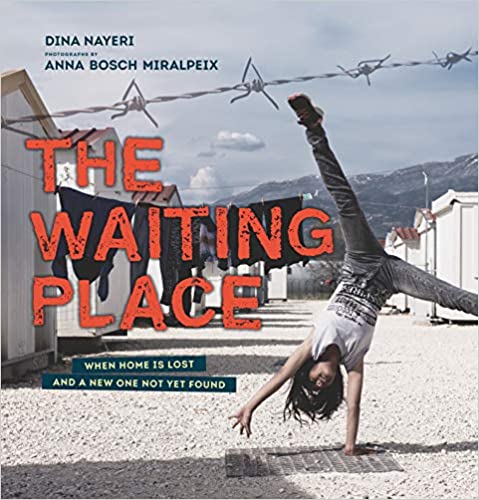I received this large, square, hardback book with an eye-catching cover from i’m your neighbor books as part of Multicultural Children’s Book Day 2023. The title, The Waiting Place, lays in bright, red, capital letters over a photo of a scene that one might drive on the way to somewhere else. There’s a child upside down in an impressive cartwheel, evoking childhood joy, next to the incongruous subtitle: “When home is lost and a new one not yet found.” To be honest, the cover and its implications made me want to look away; it took a while for me to open the book.
The Waiting Place is a 64-page book of stunning photographs with limited words. Marketed for 12-17 year olds, The Waiting Place is a must read for everyone, regardless of age. It is compelling and disturbing, as it should be.
There are 82.4 million forcibly displaced people, author Dina Nayeri notes in the afterword. Some of them will experience part of their childhood in refugee camps, as Dina did. They will grow up, become writers and doctors and teachers and programmers. They are our neighbors. This book shows a slice of the experience that some of them have lived.
Nayeri personifies the refugee camp, the waiting place, and it becomes a predator: “At first the Waiting Place welcomes you. It has heard of the wars, the famines and the bombs in your home; it is very sorry. It has been waiting for you.” Then: “Inside its gated mouth is a dreary, lazy encampment where there is nothing to do but drift. Children wait, let time slip away. They forget things: first their sums, street names, their best books. Then beloved faces, stories. The Waiting Place doesn’t mind. It wants more children and mothers and fathers. It doesn’t want you to visit the nearby lake, to hike the frosted mountain, to learn your new language, or to work or build or learn. It craves your hours, weeks, years.”
But Nayeri relieves the reader by interspersing the chilling text with the most mundane, familiar details of life. Brothers fight. Kids make artwork. Families cook. And the photos are not sad. There is adorable, five-year old Matin from Afghanistan making a monster face. His ten-year old sister, Mobina is shown lost in her thoughts, examining a flower, in a field of weeds. Kosar, a Hazara girl from Iran, jumps on her bed in her striped pajamas. The raw description of the place alongside pictures of children being children left me disquieted. I can’t stop staring at the photos, completely taken in by the spirit in these children’s eyes–the same spirit I see in my own children’s eyes. I suppose that’s the point.
Nayeri doesn’t offer a sugar-coated ending because there isn’t one. We don’t know if these specific children are still at Katsikas camp in Greece, and if not, who are the children who might now be living in the lined-up shipping crates that they called home. From my own life advocating for Palestinian rights, I know the only way to process hard truths and still avoid despair is to take action. Candlewick Press offers a discussion guide and there are engagement ideas at https://imyourneighborbooks.org/waiting-place-engage/.
But for engagement to be anything other than guilt-driven charity, readers of The Waiting Place will need to understand that while refugee camps may feel like perpetrators to children, it is people who continue to cause displacement through decisions that lead to war and other conditions that force people to run from their homes. And it is well-intentioned people like me who too often remain silent and let those bad leaders get away with it. As I recently posted in relation to Palestine, angst is not an act of solidarity. For me to live up to the expectation of this #MustRead book, I will have to take political action. I will have to do my part to influence my own government to stop creating the conditions that lead to the need for refugee camps that steal childhoods.
Later: I keep pondering this book! I’m thinking about Palestinian kids who are born, live and die in refugee camps just waiting. They go to school, waiting. They get married, waiting. They become grandparents, waiting. What’s it like when generations live without a home, without papers, without hope – waiting?
The Waiting Place
Dina Nayeri with photographs by Anna Bosch Miralpeix
Candlewick Press, 2022
978-1-5362-1362-1
